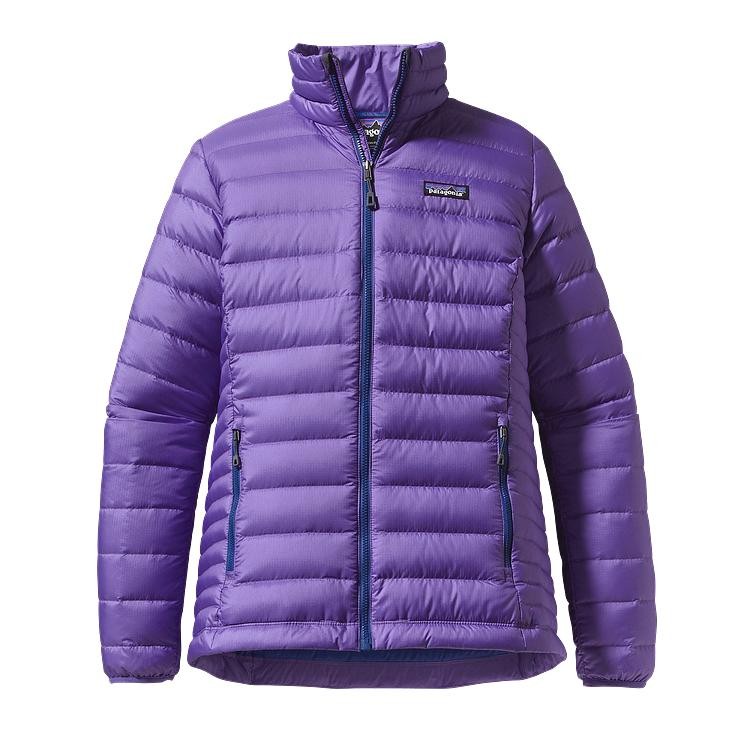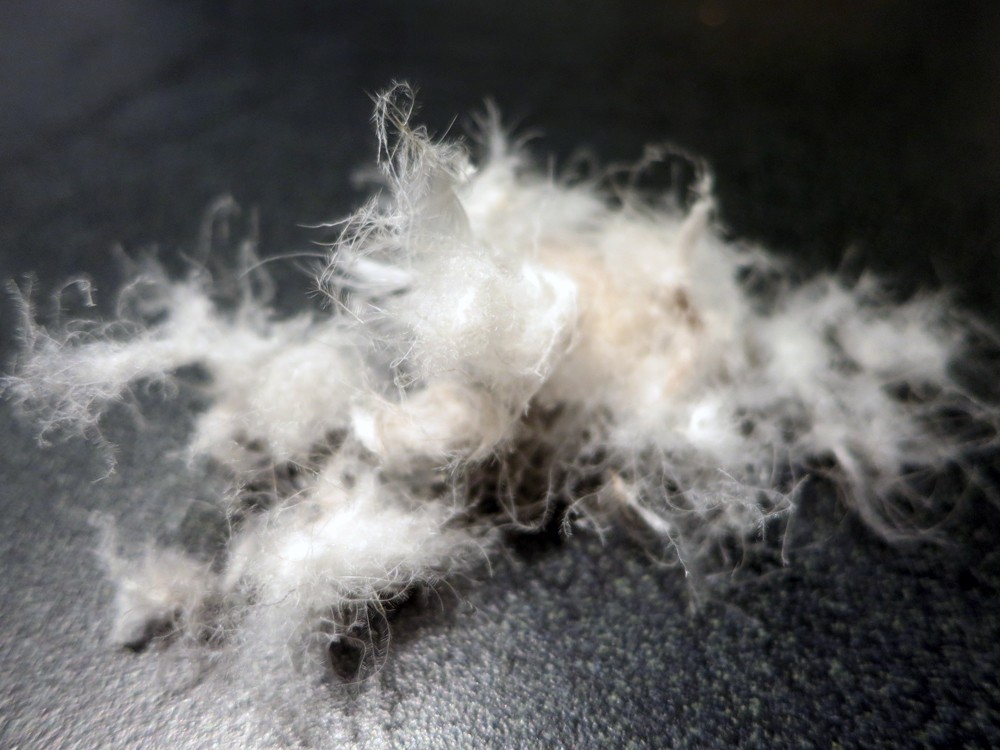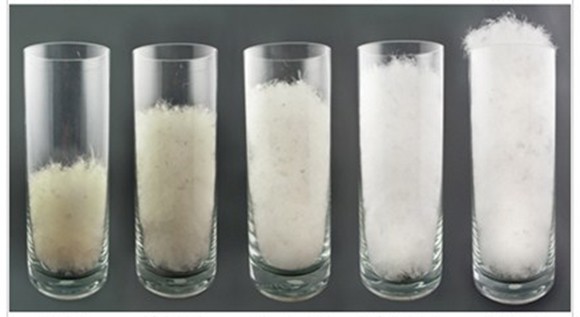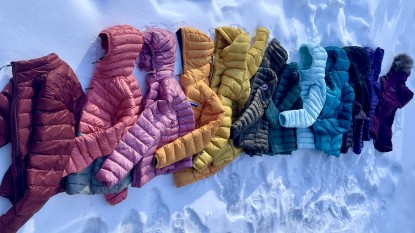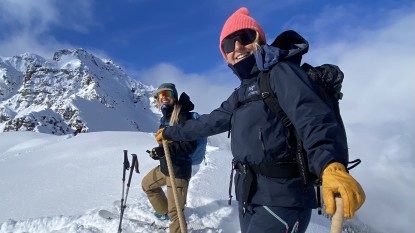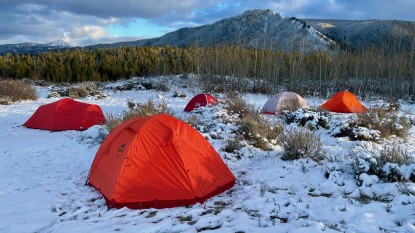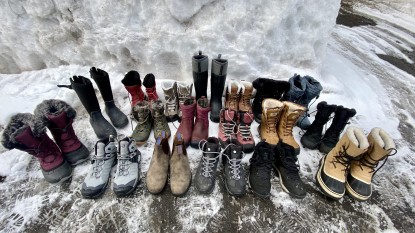Down jackets feature some of the most advanced insulation technology ever discovered by humans: the down feather. Despite our best efforts to learn from and improve upon this technology, there is still nothing quite as warm and lightweight as a down feather. This valuable, renewable resource can last for years if you care for it, making it wise to select something of very high quality that will last through many adventures. Just what is it that makes one down jacket better than another? Isn't all down created equal? We will address and assess these questions here. When you're ready to start searching for your optimal garment, head on over to our best women's down jacket review.
Responsible Down Standard
Many down jacket manufacturers are now taking the sourcing of their materials more seriously. Down is an animal product prone to the pitfalls of natural resource management strategies. It is easier now to find jackets certified to the Responsible Down Standard (RDS). The RDS website explains that the standard is an independent, voluntary global standard, and states their goal as such, “The Responsible Down Standard aims to ensure that down and feathers come from animals that have not been subjected to unnecessary harm. We hope that the standard can be used to reward and influence the down and feather industry to incentivize practices that respect the humane treatment of ducks and geese. We believe that education — through the RDS — is a meaningful way to drive demand for strong animal welfare practices. The standard also provides companies and consumers with a tool to know what is in their products, and to make accurate claims.”
Patagonia was the first of the products in this review to take on the ethics of animal welfare with their down products with their Traceable Down Standard and other companies have caught on. Why? Patagonia explains on the website: “All of the virgin down that Patagonia sources is traced from parent farm to apparel factory, so that the birds that supply it are protected by the Global Traceable Down Standard (Global TDS), one of the strongest animal-welfare and consumer-assurance standards for the goose and duck down supply chain. These include robust requirements in all areas of the birds' lives and especially protects against force feeding and live plucking.”
We've appreciated seeing the evolution of the down jacket industry toward more humane materials, allowing consumers to vote for these improved practices with the dollars we spend.
Synthetic Insulation
This is a jacket insulated with human-made fibers. It is heavier for its weight than down and doesn't compress as well. However, unlike down, it retains its loft when wet and still keeps you warm. Synthetic jackets are more durable in the short term because if you tear a hole in the outer material, the insulation doesn't leak out. But down is more durable over the long term and can handle more compressions and expansions. Synthetic jackets are usually less expensive.
Down Insulation
Down is the ultimate in insulation: it has the highest warmth-to-weight ratio and is highly compressible, great for the weight-conscious outdoors person. Best of all, a good down jacket will last for years. However, the jackets often need some attention if you want them to last (careful washing and drying, dry, and lofted storage), and you need to be careful not to rip them, or the feathers can leak out and leave you with no insulation. Moisture is down's Achilles heel; when it absorbs water, the feathers clump together and lose their loft--and, therefore, their insulating capability. These jackets tend to be expensive and get more so as the quality of the down improves.
Down vs. Synthetic Insulation
Down
The down in our jackets and sleeping bags primarily comes from geese or ducks and is a byproduct of the poultry industry. It is a soft and fluffy feather that sits underneath tougher protective feathers. A fluffy baby duck is so silky soft because it is covered in warm down feathers. The best quality down, however, comes from mature adults — and goose down is typically of higher quality than duck down.
The insulating power of down comes from its ability to trap and hold air still in the jacket. When you see a bird fluffing its feathers, it is adding more air to its down feathers to trap more body heat. In high-quality down, there are roughly two million interlocking and overlapping fluffy filaments that do this job. More mature down has more pockets that will trap air.
Down, however, has one major Achilles heel; when it gets wet, it has no insulating properties whatsoever. Birds have perfectly engineered feathers with interlocking barbs and a waxy coating that makes them wind and waterproof. Humans need Gore-Tex (or an equivalent waterproof material). We know from oil spills that when a bird's feathers get covered in oil, they cannot interlock to be waterproof anymore. The feathers become matted, and the down underneath gets wet, becomes compressed, and loses its insulating properties. In the gravest of mountain situations, the story can read similarly, but all you need is a massive winter storm, or an exploded hydration bladder in your backpack to saturate even the most water-resistant jackets.
Synthetic
Synthetic insulation is one answer to the problem of wet down. Primaloft is one of the most common types found in garments, including jackets and gloves. Synthetic insulation keeps its loft when it gets wet, so it will still keep you warm (somewhat; don't expect to feel toasty when sitting in a soggy jacket). The tradeoff, however, is it is not as light or compressible as down and tends to wear out much faster. A high-quality down product can last well over a decade if well cared for (and can be rejuvenated with a careful washing); however, synthetics will usually expire in the 5-10 year range.
Hydrophobic Down?
Several review cycles ago, waterproof down was all the rage. Hydrophobic down seems to have lost its appeal in the last year or so.
We imagine this is because it is a costly treatment process, and the benefits are too difficult to measure. We were largely unable to distinguish benefits of treated down in our field testing. The outer materials seemed to make the most difference in whether or not the down in our jackets got wet or not.
The International Down and Feather Bureau (IDFB) states:
IDFB is neutral toward the application of treatments for down and feathers; IDFB believes that natural down and feathers are an extraordinary material without treatments. However, government regulations, buyer requirements, and market demands may require treatments for down and feathers. Therefore IDFB has developed a series of DWR test methods to evaluate DWR products."
In one of these testing methods, referred to as the “hydrophobic shake test,” the IDFB takes down and puts it in a container with water, then shakes it. The “failure” point is when the feathers begin to take on water. For natural down, this is an impressive 22 minutes of immersion-shake-time. To be able to call a product “hydrophobic down” or “water-resistant down”, the down must endure an additional 20-30 minutes or a minimum of 40 minutes shake time. Sounds comical, we agree, but our general take-home point is down is pretty amazing.
Our ultimate conclusion is that these coatings can help, but they aren't necessarily a miracle. At most, they expand the range of use of a down jacket, and let it retain its warmth for slightly longer, but hydrophobic down is not a replacement for synthetic insulation or a protective shell in wet conditions.
Fill Power
A common misconception with down is that a higher fill number equates to more warmth; this is not quite the case. Down fill power is a way of gauging the quality of a down product, as measured by the warmth-to-weight ratio. Most jackets will range from 550 to 850 or even higher. A rating of 800 fill means that one ounce of down equals 800 cubic inches of loft (when compressed by a standardized weight). This means that a 550-fill jacket can be just as warm as an 850-fill jacket, but it will be bulkier, less compressible, and heavier.
After harvesting down (typically from geese), it is cleaned, dried, and sorted according to quality. The down is blown across several tubes — the down that travels the farthest is the lightest, so it falls in the high-quality tube. The heavy down falls sooner and lands in the lower quality tube.
Lower quality down products may also be diluted with feathers or feather pieces, so purchasing down from a reputable source or brand is essential. Over a relatively short amount of time, these cut feather pieces will lay flat and provide little to no loft. They can also be sharper, poking through and escaping out of the garment's outer fabric.
Construction
High-quality down won't get you far if it isn't stitched together with strong fabrics and a thoughtful design.
Sewn-Through Design
This design is the easiest to manufacture. The name says it all — the baffles holding the down are sewn through the whole jacket. The profile of this type of baffle design looks like a series of pointed ovals; each joined at the point with a single stitch. Simple doesn't necessarily mean cheap, however. This design makes jackets lighter and more compressible and gives them a better range of motion. However, because there is a pinch point at the end of each baffle, the down gets compressed and makes that a potential point of heat loss. This single seam can also be less windproof.
Box Baffle Design
The box baffle design is the warmest structure for a jacket, but it is more complicated and involves more fabric, so it will typically be more expensive, bulky, and a little heavier. This is the design most common in expedition weight parkas. Imagine each baffle as its own six-sided, long rectangular box. Each baffle is joined to the next by one side of that box (the shortest side). This eliminates the pinch point between baffles so that the down can retain more of its loft, and wind won't sneak through the single seam.
Fabrics
This category can get highly complicated with words like denier, ripstop and taffeta, funny proprietary names, and lots of numbers and measurements. All of those descriptions and numbers essentially translate to four things we care about in down jackets: Durability, down-proofness, weather resistance, and softness. The good news is that it is usually pretty intuitive. When you feel a fabric, you can often tell whether or not it will be durable, and this can give a reasonable indication of how wind and water-resistant the jacket will be. This can then be checked against the reported denier rating of a fabric, which has to do with thread count.
With all other variables held constant, a lower denier (thread thickness) number for a fabric means it is lighter but not as abrasion resistant and more likely to let pokey down feathers escape from the jacket. However, fabric strength and tear resistance typically rely more on the manufacturing than the denier (which has more to do with weight). Enter the ripstop pattern, visible upon close inspection of your jacket. This grid pattern weaved into fabrics stops a knick from becoming a rip.
Interestingly, the fabric can also affect our next category, warmth, by how permeable it is to wind. The Pertex Quantum fabric, for example, is designed to trap still air inside the jacket, thus promoting more lofting.
Warmth
Unlike sleeping bags, jackets do not come with a warmth rating. A common misconception is that a higher fill power means the jacket will be warmer. Buying an 850-fill jacket will be very warm for the weight, but it may not be suitable for your uses if it is an ultra-lightweight jacket. Jacket descriptions will help you find the right jacket, as many manufacturers will identify a lightweight jacket as such — or they might even suggest the jacket be used as a mid-layer insulation piece. Generally, the thicker and loftier, the warmer the jacket will be.
Features
Hood
There is a whole lot of surface area on your head from which to lose heat. As such, hoods can be awesome, but it depends on the use of the jacket. If it's a lighter-weight midlayer, maybe you don't want a hood, so the jacket will slide nicely in between your shell and a lightweight fleece without a hood bunching up behind your neck. Some hoods are designed to fit over a helmet and others underneath. Again, the application should fit the use; a beefy jacket should have a hood that fits over a helmet, while a midlayer or lightweight jacket should have a sleek and snug-fitting hood that you barely know is there.
Zippers
It is counter-intuitive, but in our experience, plastic zippers are more durable than metal zippers, which can bend and warp. The plastic doesn't always look as slick, but we preferred it; we want our jackets to last.
Another consideration with zippers is their position and alignment. Many times, we've caught our jacket's fabric in the zippers when we were in a rush. Lighter fabrics, which are used more and more, tend to be much more at risk of getting micro-tears and holes from getting pinched in zippers. We investigate all zippers thoroughly before purchasing a down jacket; it's such a bummer to get a hole in your expensive jacket from a poorly placed zipper.
Stuffable/Clippable
This is likely the first feature any climber or backpacker will look for. A lightweight down jacket that is good for rock, alpine, and ice climbing will stuff down very small into its pocket and have a sewn-in loop that you can clip to the back of your harness. No need for a backpack to carry your warm layer on a fast-and-light mission, and it is ready for the draw at those icy hanging belays.
Style
Even the most beautiful athletic models still don't seem to make most down jackets look very sexy. They're boxy, bulky, and not entirely flattering. Some lighter weight models are starting to show some feminine lines, with stylish baffling and stitching to accentuate curves or play with the eye, like the Lululemon Pack It Down jacket. But overall, our reviewers often feel they more closely resemble the Michelin man in their bulky jackets. For some more flattering jackets, check out our best women's winter jacket review, which includes some casual, long parkas.
Price
A down jacket is an investment, and one well worth making. If you spend the extra cash on a good one and take good care of it, it can last for years and withstand regular use and abuse. A down jacket is arguably the single most important item in the avid outdoorsperson's clothing quiver. Skimping now will not save you money in the long run.



